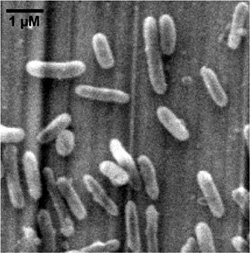| |

Photo credit:
T.E. Letain, S.I. Martin, H.R. Beller |
Thiobacillus denitrificans is
a widely distributed and well-characterized obligate chemolithoautotrophic
bacterium with an unusual metabolic repertoire that is relevant to environmental
concerns. T. denitrificans is best known for its ability to couple
the oxidation of inorganic sulfur compounds (such as hydrogen sulfide and
thiosulfate) to denitrification, although it was recently found to couple
the anaerobic oxidation of Fe(II) to denitrification as well. Among the
inorganic electron donors that T. denitrificans can utilize are
poorly-soluble minerals containing reduced iron and/or sulfur, such as
pyrite (FeS2) and FeS. The mechanism by which this
species can use solid-phase electron donors that cannot be taken into the
cell is of considerable interest but is currently unknown. T. denitrificans differs
from many known chemolithotrophic sulfur-oxidizing bacteria (such as Acidithiobacillus
ferrooxidans) in that it is a facultative anaerobe (it can respire
aerobically or via denitrification) rather than an obligate aerobe and
lives at circumneutral rather than acidic pH.
From an environmental perspective, T. denitrificans is a natural agent
for intrinsic bioremediation of a major groundwater contaminant - - nitrate.
Many recent studies have shown that chemolithoautotrophic denitrification with
pyrite or other reduced sulfur minerals as electron donors can be an important
means of natural remediation of nitrate-contaminated groundwater. Nitrate contamination
of groundwater is a pervasive and high-priority concern in rural and urban areas
throughout the United States, at legacy Department of Energy sites, and in many
regions worldwide. In addition to its remediation role in natural nitrate-contaminated
environments, T. denitrificans has been used in engineered water treatment
systems for nitrate removal. Regarding another environmental concern, the ability
of T. denitrificans to carry out nitrate-dependent Fe(II) oxidation
under anaerobic conditions could influence metal and radionuclide transport in
the subsurface, as ferric iron-containing minerals that may be formed, especially
iron(III) oxides, are well known for their ability to adsorb heavy metals and
radionuclides, such as uranium.
Prior to genome sequencing, much of the molecular work with T. denitrificans had
focused on genes associated with CO2 fixation (this species
has both form I and form II ribulose 1,5-bisphosphate carboxylase/oxygenase or
RubisCO) and to a much lesser extent with sulfur oxidation (such as the gene
coding for adenylylsulfate:phosphate adenylyltransferase, which catalyzes one
step of AMP-dependent oxidation of sulfite to sulfate via APS). Availability
of the whole genome will facilitate study of nitrate-dependent Fe(II) oxidation
(the underlying biochemistry and genetics of which are currently not known in
any bacteria) and how physical/chemical factors regulate the environmentally-relevant
metabolic activities of T. denitrificans, potentially leading to improved
methods for reliable prediction and detection of such activities in subsurface
environments.
Publication:
Beller, H. R., P. S. G. Chain, T. E. Letain, A. Chakicherla, F. W.
Larimer, P. M. Richardson, M. Coleman, A. P. Wood, and D. P. Kelly.
2006. The genome sequence of the obligately chemolithoautotrophic,
facultatively anaerobic bacterium Thiobacillus denitrificans. J.
Bacteriol. 188:1473-1488. |

